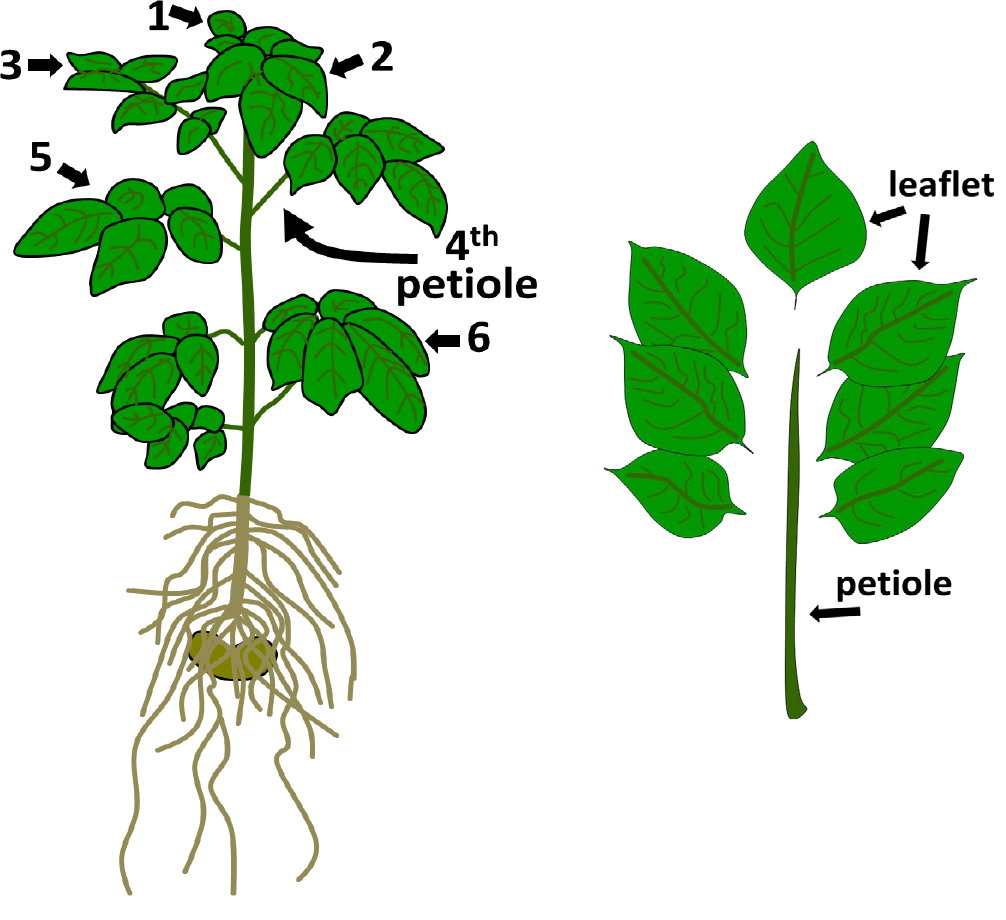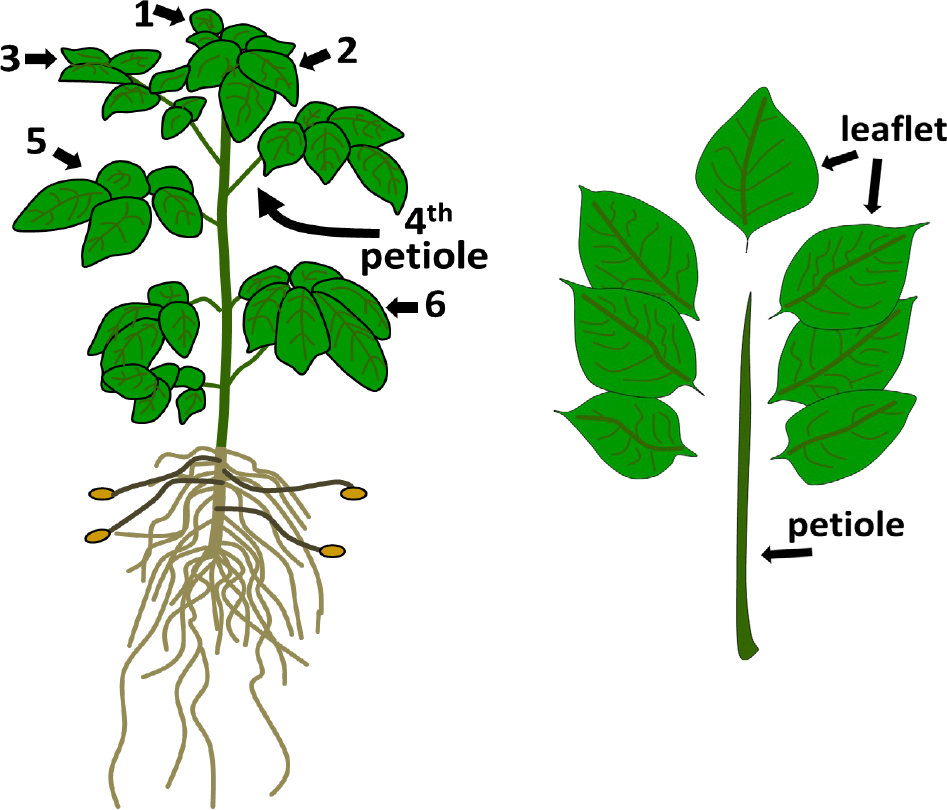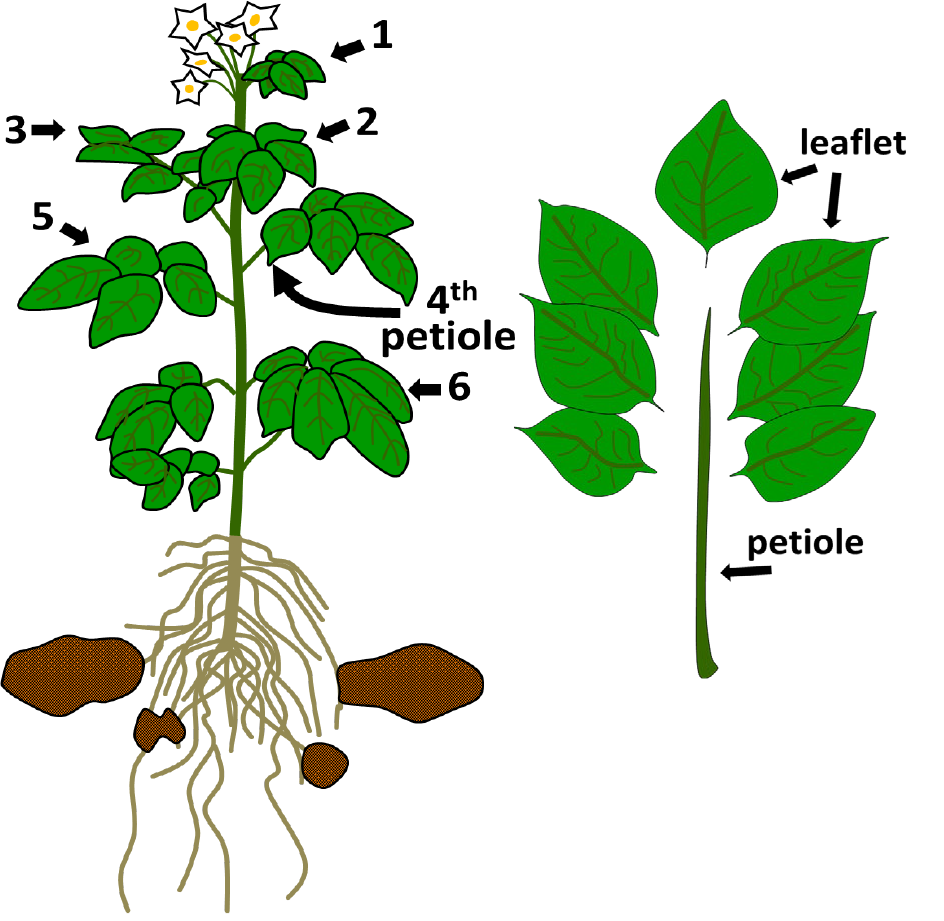⇦ Back to Soil Fertility and Plant Nutrition Home
¶ Potato (Solanum tuberosum)
| Table No: | Growth stage: | Plant part: |
| Table A | Vegetative growth | Petiole |
| Table B | Tuber initiation | Petiole |
| Table C | Tuber bulking | Petiole |
¶ A: Vegetative growth
Plant Part: Petiole from most recently emerged, fully mature leaf
Sampling Procedure: Collect the petioles from the first fully expanded leaf (often the fourth or possibly fifth from the growing tip). Remove the leaflets and save the petiole. Collect 30 to 40 petioles for complete analysis. Collect 15 to 20 petioles for nitrate only analysis. Sample different varieties separately. Do not mix varities. Pack petioles loosely in a paper bag. Do not use plastic bags
| Analysis | Tissue Concentration Guidelines | ||||||||
| Low/Marginal Range | Sufficiency Range | Excessive, toxic? | |||||||
| Nitrogen, % N | 17000 | - | 20000 | 20000 | - | 25000 | |||
| Phosphorus, %P | 950 | - | 1250 | 1250 | 3200 | ||||
| Potassium, % K | 0.20 | - | 0.25 | 0.25 | - | 0.50 | |||
| Calcium, % Ca | 7.00 | - | 8.00 | 8.00 | - | 11.00 | |||
| Magnesium, % Mg | 0.40 | - | 0.60 | 0.60 | - | 1.50 | |||
| Sulfur, % S | 0.15 | - | 0.30 | 0.30 | - | 1.50 | |||
| Zinc, ppm Zn | 0.20 | - | 0.22 | 0.22 | - | 0.35 | |||
| Iron, ppm Fe | 15 | - | 25 | 25 | - | 45 | 500 | - | 750 |
| Manganese, ppm Mn | 20 | - | 50 | 50 | - | 200 | |||
| Copper ppm Cu | 20 | - | 30 | 30 | - | 300 | 600 | - | 800 |
| Boron, ppm B | 2 | - | 4 | 4 | - | 20 | |||
| Nitrogen-to-sulfur ratio (N:S) | 10 | - | 20 | 20 | - | 40 | 120 | - | 180 |
| Sodium, % Na | 0.25 | - | 0.50 | ||||||
| Chloride, % Cl | |||||||||
| Nitrate, ppm NO3-N | |||||||||
| Phosphate, ppm PO4-P | |||||||||
¶ Figure A.

¶ B: Tuber initiation
Plant Part: Petiole from most recently emerged, fully mature leaf
Sampling Procedure: Collect the petioles from the first fully expanded leaf (often the fourth or possibly fifth from the growing tip). Remove the leaflets and save the petiole. Collect 30 to 40 petioles for complete analysis. Collect 15 to 20 petioles for nitrate only analysis. Sample different varieties separately. Do not mix varities. Pack petioles loosely in a paper bag. Do not use plastic bags.
| Analysis | Tissue Concentration Guidelines | ||||||||
| Low/Marginal Range | Sufficiency Range | Excessive, toxic? | |||||||
| Nitrogen, % N | 15000 | - | 18000 | 18000 | - | 22000 | |||
| Phosphorus, %P | 800 | - | 1100 | 1100 | 2800 | ||||
| Potassium, % K | 0.17 | - | 0.22 | 0.22 | - | 0.45 | |||
| Calcium, % Ca | 5.00 | - | 6.00 | 6.00 | - | 9.00 | |||
| Magnesium, % Mg | 0.40 | - | 0.60 | 0.60 | - | 1.50 | |||
| Sulfur, % S | 0.15 | - | 0.30 | 0.30 | - | 1.50 | |||
| Zinc, ppm Zn | 0.18 | - | 0.22 | 0.22 | - | 0.35 | |||
| Iron, ppm Fe | 15 | - | 25 | 25 | - | 45 | 500 | - | 750 |
| Manganese, ppm Mn | 20 | - | 50 | 50 | - | 200 | |||
| Copper ppm Cu | 20 | - | 30 | 30 | - | 300 | 600 | - | 800 |
| Boron, ppm B | 2 | - | 4 | 4 | - | 20 | |||
| Nitrogen-to-sulfur ratio (N:S) | 10 | - | 20 | 20 | - | 40 | 120 | - | 180 |
| Sodium, % Na | 0.25 | - | 0.50 | ||||||
| Chloride, % Cl | |||||||||
| Nitrate, ppm NO3-N | |||||||||
| Phosphate, ppm PO4-P | |||||||||
¶ Figure B.

¶ C: Tuber bulking
Plant Part: Petiole from most recently emerged, fully mature leaf
Sampling Procedure: Collect the petioles from the first fully expanded leaf (often the fourth or possibly fifth from the growing tip). Remove the leaflets and save the petiole. Collect 30 to 40 petioles for complete analysis. Collect 15 to 20 petioles for nitrate only analysis. Sample different varieties separately. Do not mix varities. Pack petioles loosely in a paper bag. Do not use plastic bags
| Analysis | Tissue Concentration Guidelines | ||||||||
| Low/Marginal Range | Sufficiency Range | Excessive, toxic? | |||||||
| Nitrogen, % N | 8500 | - | 10000 | 10000 | - | 16000 | |||
| Phosphorus, %P | 750 | - | 1050 | 1050 | 2800 | ||||
| Potassium, % K | 0.17 | - | 0.22 | 0.22 | - | 0.45 | |||
| Calcium, % Ca | 3.20 | - | 4.00 | 4.00 | - | 6.00 | |||
| Magnesium, % Mg | 0.40 | - | 0.60 | 0.60 | - | 1.50 | |||
| Sulfur, % S | 0.15 | - | 0.30 | 0.30 | - | 1.50 | |||
| Zinc, ppm Zn | 0.15 | - | 0.18 | 0.18 | - | 0.30 | |||
| Iron, ppm Fe | 10 | - | 20 | 20 | - | 40 | 500 | - | 750 |
| Manganese, ppm Mn | 20 | - | 50 | 50 | - | 200 | |||
| Copper ppm Cu | 25 | - | 40 | 40 | - | 300 | 600 | - | 800 |
| Boron, ppm B | 2 | - | 4 | 4 | - | 20 | |||
| Nitrogen-to-sulfur ratio (N:S) | 15 | - | 25 | 25 | - | 50 | 120 | - | 180 |
| Sodium, % Na | 0.25 | - | 0.50 | ||||||
| Chloride, % Cl | |||||||||
| Nitrate, ppm NO3-N | |||||||||
| Phosphate, ppm PO4-P | |||||||||
¶ Figure C.

Note: Petiole analysis results are best interpreted from trends over the growing season and not on results from a single sampling date. Results from a single sample may be affected by time of day, climatic conditions, plant stress, age, or disease, that are not directly related to fertility status. Nutrient concentrations are not uniform throughout the plant and may change as the tissue matures. Petiole analysis trends should be evaluated by variety, growing season, and yield/quality goals. Collecting petioles from the same location as soil samples allows comparison of soil nutrient availability with petiole nutrient status.
Interpretations are based the relationship between nutrient levels in a particular part of a "standard" tissue in a specific time in the growing season.
These plant tissue ranges and interpretations are not considered valid with plant parts or growth stages other than those specified. These interpretations are developed from data collected across a wide range of crop, soil, and climate conditions.
Low nutrient levels may be due to deficiency or to dilution by intensive growth. High or excessive nutrient levels may be a sign of restricted growth allowing nutrients to accumulate in the plant tissue.